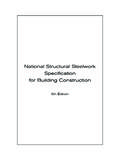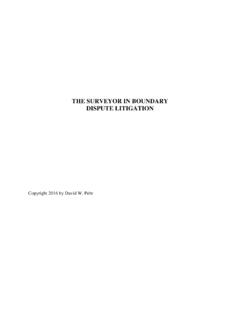Transcription of CIVIL FORMULAS - Engineering Surveyors
1 CIVILENGINEERINGFORMULAS ABOUT THE AUTHORT yler G. Hicks, , is a consulting engineer and a successful engi-neering book author. He has worked in plant design and operationin a variety of industries, taught at several Engineering schools, andlectured both in the United States and abroad. Mr. Hicks holds abachelor s degree in Mechanical Engineering from Cooper UnionSchool of Engineering in New York. He is the author of more than100 books in Engineering and related G. Hicks,P. E .International Engineering AssociatesMember: American Society of Mechanical EngineersUnited States Naval InstituteSecond EditionNew York Chicago San Francisco Lisbon London MadridMexico City Milan New Delhi San Juan SeoulSingapore Sydney TorontoCopyright 2010, 2002 by The McGraw-Hill Companies, Inc.
2 All rights reserved. Except as permittedunder the United States Copyright Act of 1976, no part of this publication may be reproduced or distrib-uted in any form or by any means, or stored in a database or retrieval system, without the prior writtenpermission of the : 978-0-07-161470-2 MHID: 0-07-161470-2 The material in this eBook also appears in the print version of this title: ISBN: 978-0-07-161469-6,MHID: trademarks are trademarks of their respective owners. Rather than put a trademark symbol after everyoccurrence of a trademarked name, we use names in an editorial fashion only, and to the benefit of thetrademark owner, with no intention of infringement of the trademark. Where such designations appearin this book, they have been printed with initial eBooks are available at special quantity discounts to use as premiums and sales promotions, or for use in corporate training programs.
3 To contact a representative please e-mail us contained in this work has been obtained by The McGraw-Hill Companies, Inc. ( McGraw-Hill ) from sources believed to be reliable. However, neither McGraw-Hill nor its authors guarantee theaccuracy or completeness of any information published herein, and neither McGraw-Hill nor its authorsshall be responsible for any errors, omissions, or damages arising out of use of this information. Thiswork is published with the understanding that McGraw-Hill and its authors are supplying informationbut are not attempting to render Engineering or other professional services. If such services are required,the assistance of an appropriate professional should be OF USEThis is a copyrighted work and The McGraw-Hill Companies, Inc.
4 ( McGraw-Hill ) and its licensorsreserve all rights in and to the work. Use of this work is subject to these terms. Except as permitted underthe Copyright Act of 1976 and the right to store and retrieve one copy of the work, you may not decompile, disassemble, reverse engineer, reproduce, modify, create derivative works based upon, transmit, distribute, disseminate, sell, publish or sublicense the work or any part of it without McGraw-Hill s prior consent. You may use the work for your own noncommercial and personal use; anyother use of the work is strictly prohibited. Your right to use the work may be terminated if you fail tocomply with these WORK IS PROVIDED AS IS.
5 McGRAW-HILL AND ITS LICENSORS MAKE NO GUARAN-TEES OR WARRANTIES AS TO THE ACCURACY, ADEQUACY OR COMPLETENESS OF ORRESULTS TO BE OBTAINED FROM USING THE WORK, INCLUDING ANY INFORMATIONTHAT CAN BE ACCESSED THROUGH THE WORK VIA HYPERLINK OR OTHERWISE, ANDEXPRESSLY DISCLAIM ANY WARRANTY, EXPRESS OR IMPLIED, INCLUDING BUT NOTLIMITED TO IMPLIED WARRANTIES OF MERCHANTABILITY OR FITNESS FOR A PARTICU-LAR PURPOSE. McGraw-Hill and its licensors do not warrant or guarantee that the functions containedin the work will meet your requirements or that its operation will be uninterrupted or error free. NeitherMcGraw-Hill nor its licensors shall be liable to you or anyone else for any inaccuracy, error or omission,regardless of cause, in the work or for any damages resulting therefrom.
6 McGraw-Hill has no responsibility for the content of any information accessed through the work. Under no circumstancesshall McGraw-Hill and/or its licensors be liable for any indirect, incidental, special, punitive, consequen-tial or similar damages that result from the use of or inability to use the work, even if any of them hasbeen advised of the possibility of such damages. This limitation of liability shall apply to any claim orcause whatsoever whether such claim or cause arises in contract, tort or to Use This BookxvChapter 1. Conversion Factors for CIVIL Engineering Practice1 Chapter 2. Beam Formulas11 Continuous Beams /11 Ultimate Strength of Continuous Beams /46 Beams of Uniform Strength /52 Safe Loads for Beams of Various Types /53 Rolling and Moving Loads /53 Curved Beams /65 Elastic Lateral Buckling of Beams /69 Combined Axial and Bending Loads /72 Unsymmetrical Bending /73 Eccentric Loading /73 Natural Circular Frequencies and Natural Periods of Vibration of Prismatic Beams /74 Torsion in Structural Members /76 Strain Energy in Structural Members /76 Fixed-End Moments in Beams /79 Chapter 3.
7 Column FORMULAS 81 General Considerations /81 Short Columns /81 Eccentric Loads on Columns /83 Columns of Special Materials /88 Column Base Plate Design / 90 American Institute of Steel Construction Allowable-Stress Design Approach /91 Composite Columns /92 Elastic Flexural Buckling of Columns /94 Allowable Design Loads for Aluminum Columns /96 Ultimate Strength Design Concrete Columns /97 Design of Axially Loaded Steel Columns /102vChapter 4. Piles and Piling Formulas105 Allowable Loads on Piles /105 Laterally Loaded Vertical Piles /105 Toe Capacity Load /107 Groups of Piles /107 Foundation-Stability Analysis /109 Axial-Load Capacity of Single Piles /112 Shaft Settlement /112 Shaft Resistance in Cohesionless Soils /113 Chapter 5.
8 Concrete formulas115 Reinforced Concrete /115 Water/Cementitious Materials Ratio /115 Job Mix Concrete Volume /116 Modulus of Elasticity of Concrete /116 Tensile Strength of Concrete /117 Reinforcing Steel /117 Continuous Beams and One-Way Slabs /117 Design Methods for Beams, Columns, and Other Members /118 Properties in the Hardened State /127 Tension Development Lengths /128 Compression Development Lengths /128 Crack Control of Flexural Members /128 Required Strength /129 Deflection Computations and Criteria for Concrete Beams /130 Ultimate-Strength Design of Rectangular Beams with Tension Reinforcement Only /130 Working-Stress Design of Rectangular Beams with Tension Reinforcement Only /133 Ultimate-Strength Design of Rectangular Beams with Compression Bars /135 Working-Stress Design of Rectangular Beams with Compression Bars /136 Ultimate-Strength Design of I- and T-beams /138 Working-Stress Design of I- and T-beams /138 Ultimate-Strength
9 Design for Torsion /140 Working-Stress Design for Torsion /141 Flat-Slab Construction /142 Flat-Plate Construction /142 Shear in Slabs /145 Column Moments /146 Spirals /147 Braced and Unbraced Frames /147 Shear Walls /148 Concrete Gravity Retaining Walls /150 Cantilever Retaining Walls /153 Wall Footings /155viCONTENTSC hapter 6. Timber Engineering Formulas157 Grading of Lumber /157 Size of Lumber /157 Bearing /159 Beams /159 Columns /160 Combined Bending and Axial Load /161 Compression at Angle to Grain /161 Recommendations of the Forest Products Laboratory /162 Compression on Oblique Plane /163 Adjustment Factors for Design Values /164 Fasteners for Wood /169 Adjustment of Design Values for Connections with Fasteners /171 Roof Slope to Prevent Ponding /172 Bending and Axial Tension /173 Bending and Axial Compression /173 Solid Rectangular or Square Columns with Flat Ends /174 Chapter 7.
10 Surveying Formulas177 Units of Measurement /177 Theory of Errors /178 Measurement of Distance with Tapes /179 Vertical Control /182 Stadia Surveying /183 Photogrammetry /184 Chapter 8. Soil and Earthwork Formulas185 Physical Properties of Soils /185 Index Parameters for Soils /186 Relationship of Weights and Volumes in Soils /186 Internal Friction and Cohesion /188 Vertical Pressures in Soils /188 Lateral Pressures in Soils, Forces on Retaining Walls /189 Lateral Pressure of Cohesionless Soils /190 Lateral Pressure of Cohesive Soils /191 Water Pressure /191 Lateral Pressure from Surcharge /191 Stability of Slopes /192 Bearing Capacity of Soils /192 Settlement under Foundations /193 Soil Compaction Tests /193 Compaction Equipment /195 FORMULAS for Earthmoving /196 Scraper Production /197 Vibration Control in Blasting /198 CONTENTSviiChapter 9.







